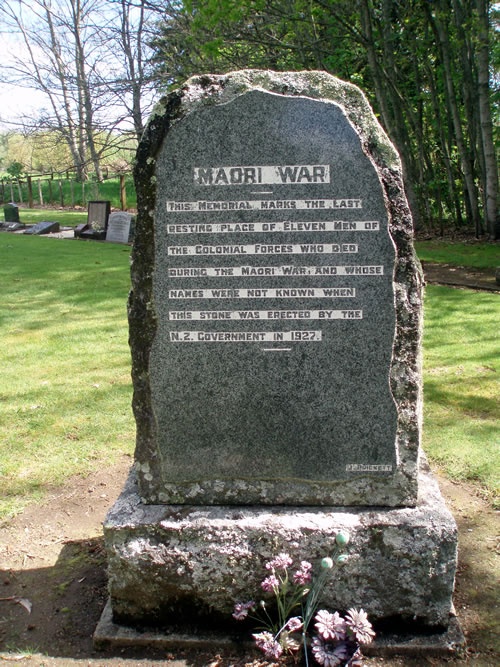
Leamington Cemetery is located at the end of Wordsworth Street in the Waikato town of Cambridge. Its old section is known as Cambridge West (Leamington) Cemetery. The first civilian burial here appears to have taken place on 17 August 1880. Nearly two decades earlier, however, the site was the burial ground for the 3rd Waikato Militia, which was based at ‘Camp Cambridge’.
Camp Cambridge was situated on both sides of the Waikato River halfway between Maungatautari and Pukerimu. The site was chosen on 13 July 1864, in part because it was the closest point to the confiscation line (aukati) that was accessible by river transport. The camp was named for the Duke of Cambridge, the commander-in-chief of the British army.
Colonel William Charles Lyon moved the 3rd Waikato Militia’s headquarters to Camp Cambridge on 11 August 1864. Between 1864 and 1866, 11 Militia troops were buried at the Cambridge West (Leamington) cemetery.
This memorial was erected by the New Zealand government in 1927. Edith Statham, Inspector of Old Soldiers’ Graves for the Department of Internal Affairs, had previously identified the site as the burial place of 11 unidentified colonial troops.
Recent research undertaken for the Cambridge Museum has discovered, to varying degrees, the identities of these men.
- Jonathan Dann died on 25 September 1864 of an apoplexy fit that his inquest found had been brought on by excessive drinking of ‘ardent spirits’.
- Frederick Higgins of the Forest Rangers drowned in the Waikato River on 23 November 1864 while partially intoxicated. At dusk his comrades discharged a farewell shot over his grave.
- Ernest Hartman drowned in the Waikato River on 4 December 1864.
- David Halliday’s body was found floating in the Waikato River on 12 December 1864. He had earlier gone missing.
- On 13 February 1865, the Daily Southern Cross’s Cambridge correspondent reported: ‘I much regret to say that a man was found hanging from a tree, about a week ago, by a party of the surveyor’s. There is little doubt that his name was Buckley. He deserted, under peculiar circumstances, about seven weeks ago, from the 3rd Waikato Regiment. The body was so much decomposed that it was impossible to identify it, but I learn that from his clothing there can be no doubt of the identity.’
- The nominal roll of the 3rd Waikato Militia states that George Commons died on 8 January 1865. The other deaths that year were of Patrick Walsh on 3 February, Daniel Sharper Smith on 23 July, and Patrick Swan, who drowned on 25 October.
- In late 1865 or early 1866, Michael Murphy was found ‘moaning in a ditch’. He later died in hospital from severe injuries to his spine, ‘the cause of which’, his inquest decided, ‘there is no evidence to prove’.
- George Wilson shot himself at 2 p.m. on 13 May 1866, leaving a note for his friend: ‘Dear Moffatt. – You will be no doubt surprised at the end I have come to. Mental distraction has driven me to this. I find I cannot get over it; so good-bye. Communicate this to my brother, J H Wilson, Grove Street, Castlemaine, Victoria. George Wilson’.
Inscription
Maori War / This memorial marks the last / resting place of eleven men of / the Colonial Forces who died / during the Maori War, and whose / names were not known when / this stone was erected by the / N.Z. Government in 1927.
J. Prickett
Further information
- ‘Cambridge. (from our own correspondent.) February 8.’, Daily Southern Cross, 13 February 1865
- Chris Maclean and Jock Phillips, The sorrow and the pride: New Zealand war memorials, GP Books, Wellington, 1990, p. 38
- Eris Parker, ‘Leamington Cemetery’, Cambridge Museum
- Eris Parker, ‘Leamington Monument’, Cambridge Museum
- Eris Parker, ‘Third Waikato Militia’, Cambridge Museum
- Eris Parker, ‘Camp Cambridge’, Cambridge Museum

Community contributions